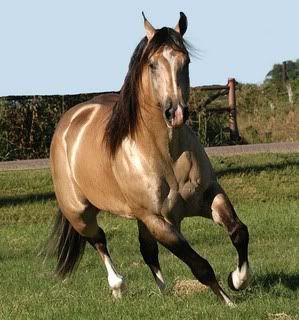 |
| An outrageously good-looking palomino Thoroughbred foal from Winning Colours Farm here in Australia. |
The gene that governs palomino, buckskin, and some other coat colours is known as solute carrier family 45 member 2 (SLC45A2). Like a good spy, this gene is sometimes also known by other names... which aren't very memorable either (one is membrane-associated transport protein, or MATP).
All horses carry two copies of the SLC45A2 gene, one inherited from their dam and one from their sire. But just like most (or all?) genes in mammals, there are lots of different versions of SLC45A2 out there. Most versions of the SLC45A2 gene allow your horse's basic coat colours - that's chestnut, bay or brown, and black - to shine through. However, one version does something special: it can turn horses that would otherwise be bay or chestnut into gold. This version of SLC45A2 is generally known as cream.
 |
| Come on, tell me that you wouldn't accidentally drool on your magazine too with pictures of handsome stallions like this (pic linked through from Buffalo Creek Ranch). |
So what happens if your horse inherits two copies of the cream version of SLC45A2? Some interesting stuff.
 |
| This is Glacial Gold (USA), a cremello Thoroughbred stallion from Winning Colours Farm. |
Horses with a basic bay, brown or black coat colour combined with two copies of the cream version of SLC45A2 are called perlino. Just like cremello horses, they have pale coats, skin and eyes. In fact, I hear that it can be difficult or impossible to tell whether a horse is cremello or perlino just from looking at its coat, because there is some individual variation in these colours too.
If, like me, you think GOLDEN HORSES! INHERITED! AWESOME!! and you'd love to breed your own, then this is what you need to keep in mind: a cremello or perlino horse will always pass on a cream version of SLC45A2. A buckskin or palomino horse has a 50% chance of passing on their cream version of SLC45A2, and a 50% chance of passing on their non-cream version of this gene.
 | |||
| Cute x golden = awww (a little-known scientific equation). Thanks again for the image, Winning Colours Farm. |
Other notes on the cream version of SLC45A2:
- When it is inherited in combination with a black coat colour, the colour described as smoky black. Just like a palomino or a buckskin, a smoky black horse has a 50% chance of passing the cream version of SLC45A2 on to its foals. I've heard it can be really hard to tell that smoky black from normal, non-cream black (without genetic testing that is) - if you own a horse this colour, tell me what it's like in the flesh. Would you know from looking at it?
- SLC45A2 is not the only gene that can carry out coat colour espionage that results in golden horses. Some other genes have versions that cause similar, or at least equally beautiful, effects. While SLC45A2 is known as the cream gene, these others are called champagne, pearl, and silver (seeing a luxury theme here anyone??). Articles on these coat colours will appear in the months to come.
No comments:
Post a Comment